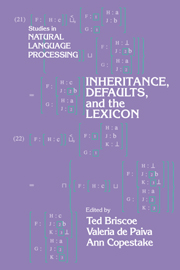Book contents
- Frontmatter
- Contents
- Contributors
- 1 Introduction
- 2 Skeptical and Credulous Default Unification with Applications to Templates and Inheritance
- 3 Prioritised Multiple Inheritance in DATR
- 4 Some Reflections on the Conversion of the TIC Lexicon into DATR
- 5 Norms or Inference Tickets? A Frontal Collision between Intuitions
- 6 Issues in the Design of a Language for Representing Linguistic Information Based on Inheritance and Feature Structures
- 7 Feature-Based Inheritance Networks for Computational Lexicons
- 8 A Practical Approach to Multiple Default Inheritance for Unification-Based Lexicons
- 9 The ACQUILEX LKB: An Introduction
- 10 Types and Constraints in the LKB
- 11 LKB Encoding of Lexical Knowledge
- 12 Defaults in Lexical Representation
- 13 Untangling Definition Structure into Knowledge Representation
- Appendix A A Bibliography of ACQUILEX Papers Connected with the LKB
- Appendix B The LKB Description Language Syntax
- Appendix C Software Availability
- References
- Author index
- Subject Index
8 - A Practical Approach to Multiple Default Inheritance for Unification-Based Lexicons
Published online by Cambridge University Press: 01 April 2010
- Frontmatter
- Contents
- Contributors
- 1 Introduction
- 2 Skeptical and Credulous Default Unification with Applications to Templates and Inheritance
- 3 Prioritised Multiple Inheritance in DATR
- 4 Some Reflections on the Conversion of the TIC Lexicon into DATR
- 5 Norms or Inference Tickets? A Frontal Collision between Intuitions
- 6 Issues in the Design of a Language for Representing Linguistic Information Based on Inheritance and Feature Structures
- 7 Feature-Based Inheritance Networks for Computational Lexicons
- 8 A Practical Approach to Multiple Default Inheritance for Unification-Based Lexicons
- 9 The ACQUILEX LKB: An Introduction
- 10 Types and Constraints in the LKB
- 11 LKB Encoding of Lexical Knowledge
- 12 Defaults in Lexical Representation
- 13 Untangling Definition Structure into Knowledge Representation
- Appendix A A Bibliography of ACQUILEX Papers Connected with the LKB
- Appendix B The LKB Description Language Syntax
- Appendix C Software Availability
- References
- Author index
- Subject Index
Summary
Introduction
Natural language lexicons form an obvious application for techniques involving default inheritance developed for knowledge representation in artificial intelligence (AI). Many of the schemes that have been proposed are highly complex – simple tree-form taxonomies are thought to be inadequate, and a variety of additional mechanisms are employed. As Touretzky et al. (1987) show, the intuitions underlying the behaviour of such systems may be unstable, and in the general case they are intractable (Selman and Levesque, 1989).
It is an open question whether the lexicon requires this level of sophistication – by sacrificing some of the power of a general inheritance system one may arrive at a simpler, more restricted, version, which is nevertheless sufficiently expressive for the domain. The particular context within which the lexicon described here has been devised seems to permit further reductions in complexity. It has been implemented as part of the ELU unification grammar development environment for research in machine translation, comprising parser, generator, lexicon, and transfer mechanism.
Overview of Formalism
An ELU lexicon consists of a number of ‘classes’, each of which is a structured collection of constraint equations and/or macro calls encoding information common to a set of words, together with links to other more general ‘superclasses’. Lexical entries are themselves classes, and any information they contain is standardly specific to an individual word; lexical and non-lexical classes differ in that analysis and generation take only the former as entry points to the lexicon.
- Type
- Chapter
- Information
- Inheritance, Defaults and the Lexicon , pp. 137 - 147Publisher: Cambridge University PressPrint publication year: 1994
- 1
- Cited by



